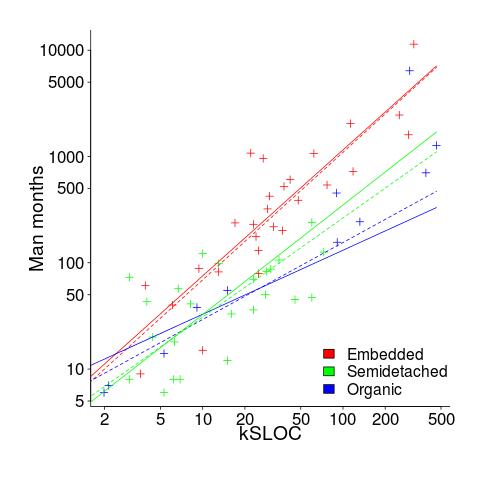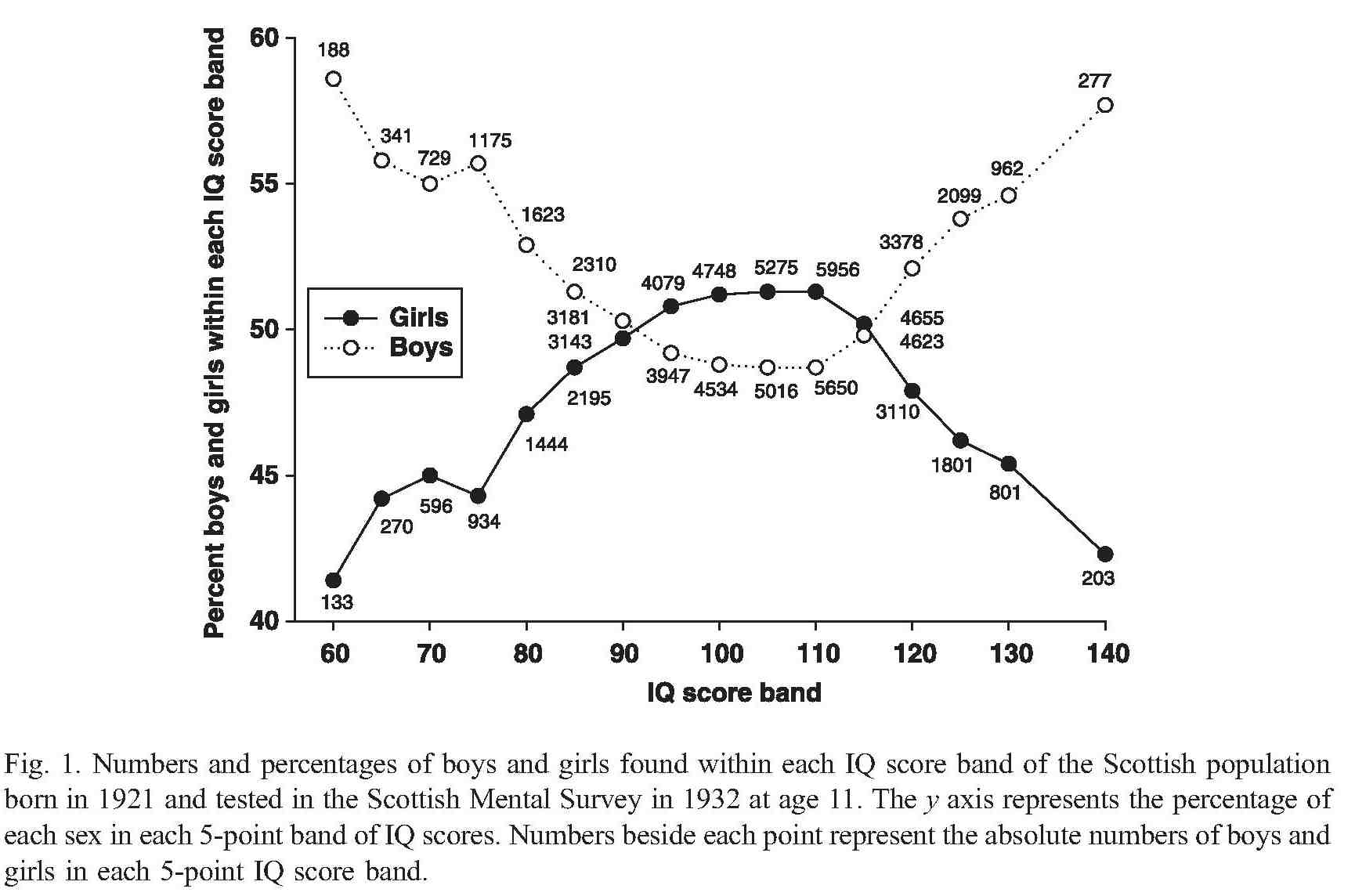Archive
COCOMO: Not worth serious attention
The Constructive Cost Model (COCOMO) was introduced to the world by the book “Software Engineering Economics” by Barry Boehm; this particular version of the model is now known by the year of publication, COCOMO 81. The book describes a model that estimates software project cost drivers, such as effort (in man months) and elapsed time; the data from the 63 projects used to help calibrate the equations appears on pages 496-497.
Only having 63 measurements to model such a complex problem means any predictions will have very wide error bounds; however, the small amount of data did not stop Boehm building an academic career out of over-fitting these 63 measurements using 17 input parameters (the COCOMO II book came out in 2000 and was initially calibrated by fitting 22 parameters to 83 measurement points and then by fitting 23 parameters to 161 measurement points; the measurement data does not appear to be publicly available).
A sentence on page 493 suggests that over-fitting may not be the only problem to be found in the data analysis: “The calibration and evaluation of COCOMO has not relied heavily on advanced statistical techniques.”
Let’s take the original data and duplicate the original analysis, before trying something more advanced (code+data).
A central plank of the COCOMO model is the equation:  , where
, where  is total effort in man months,
is total effort in man months,  a constant obtained by fitting the data,
a constant obtained by fitting the data,  thousands of lines of source code and
thousands of lines of source code and  a constant obtained by fitting the data.
a constant obtained by fitting the data.
This post discusses fitting this equation for the three modes of software projects defined by Boehm (along with the equations he fitted):
- Organic, relatively small teams operating in a highly familiar environment:
 ,
, - Embedded, the product has to operate within strongly coupled, complex, hardware, software and operational procedures such as air traffic control:
 ,
, - Semidetached, an intermediate stage between the two extremes:
 .
.
The plot below shows kSLOC against Effort, with solid lines fitted using what I guess was Boehm’s approach and dashed lines showing fitted lines after removing outliers (Figure 6-5 in the book has the x/y axis switched; the points in the above plot appear to match those in this figure):

The fitted equations are (the standard error on the multiplier,  , is around ±30%, while on the exponent,
, is around ±30%, while on the exponent,  , the absolute value varies between ±0.1 and ±0.2):
, the absolute value varies between ±0.1 and ±0.2):
- Organic:
 , after outlier removal
, after outlier removal 
- Embedded:
 , after outlier removal
, after outlier removal 
- Semidetached:
 , after outlier removal
, after outlier removal  .
.
The only big difference is for Organic, which is very different. My first reaction on seeing this was to double check the values used against those in the book. How did Boehm make such a big mistake and why has nobody spotted it (or at least said anything) before now? Papers by Boehm’s students do use fancy statistical techniques and contain lots of tables of numbers relating to COCOMO 81, but no mention of what model they actually found to be a good fit.
The table on pages 496-497 contains man month estimates made using Boehm’s equations (the EST column). The values listed are a close match to the values I calculated using Boehm’s Semidetached equation, but there are many large discrepancies between printed values and values I calculated (using Boehm’s equations) for Organic and Embedded. If the data in this table contains a lot of mistakes, it may explain why I get very different values fitting the data for Organic. Some ther columns contain values calculated using the listed EST values and the few I have checked are correct, so if there was an error in the EST value calculation it must have occurred early in the chain of calculations.
The data for each of the three modes of software development contain several in your face outliers (assuming the values are correct). Based on the fitted equations is does not look like Boehm removed these (perhaps detecting outliers is an advanced technique).
Once the very obvious outliers are removed the quadratic equation,  , becomes a viable competing model. Unfortunately we don’t have enough data to do a serious comparison of this equation against the COCOMO equation.
, becomes a viable competing model. Unfortunately we don’t have enough data to do a serious comparison of this equation against the COCOMO equation.
In practice the COCOMO 81 model has been found to be highly inaccurate and very much dependent upon the interpretation of the input parameters.
Further down on page 493 we have: “I have become convinced that the software field is currently too primitive, and cost driver interaction too complex, for standard statistical techniques to make much headway;”.
With so much complexity and uncertainty, careful application of statistical techniques is the only way of reliable way of distinguishing any signal from noise.
COCOMO does not deserve anymore serious attention (the code+data includes some attempts to build alternative models, before I decided it was not worth the effort).
More men than women are incompetent/very competent
Womens’ rights campaigners are always making a big fuss about the huge impact equal rights/sex discrimination laws have had on increasing the career opportunities for very capable women to break the ‘glass ceiling’. The very capable end of the ability scale has always been sparsely populated and any significant impact is more likely to be noticeable in the less capable bands of the scale.
When I started out working in software development, if there was a women working on a team the chances were that she would be towards the very competent end of the scale (male/female ratio back then was what, 10/1?). These days, based on my limited experience, women are less likely to be competent but still a lot less likely, than men, to be completely incompetent.
Based on my experience+talking to others it would appear that women are still underrepresented at the very competent/incompetent ends of the scale in software development. Why might this be (apart from being a sample size issue)? While the average value of male/female intelligence are the same (IQ tests are constructed to make them equal), the variance in IQ between the sexes is very different. The following is taken from Population sex differences in IQ at age 11: the Scottish mental survey 1932

The above plot provides a possible explanation for the prevalence of men at the very competent/incompetent ends of the scale and suggests that women should outnumber men in the middle, competent, band.
In practice there are still far fewer women than men working in software engineering, so a comparison using absolute counts is not possible; good luck running a survey covering software developer competence.
If the above IQ distribution carries over to competencies then it seems to me that those seeking to attract more women into software engineering, and engineering in general, should be targeting the more populous middle competence band and not the high fliers. Companies make a big fuss about wanting high fliers but in practice are often willing to take on people who are likely to be competent if they are the safer choice (that guy who appeared rather unusual during the interview may turn out to be flop rather than a rock star).
Recent Comments